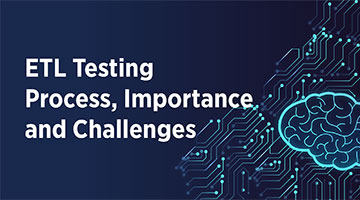Pentaho+ ETL and Data Fitness Testing Process, Importance and Challenges

The objective of Pentaho+ ETL Testing is to test the ETL process in order to ensure that data is effectively managed in the Data Warehouse.
Pentaho+ ETL Testing Process
The Pentaho+ ETL testing identifies the problems, discrepancies with the data source, as well as uncertain business rules applied in the integration. To overcome this, the below process is followed,
- Data Mapping or Transformation: Verify that data is transformed correctly according to various business requirements and rules.
- Source to Target count: Make sure that the count of records loaded in the target is matching with the expected count.
- Source to Target Data: Make sure that all projected data is loaded into the data warehouse without any data loss and truncation.
- Data Quality: Make sure that ETL application appropriately rejects, replaces with default values and reports invalid data.
- Performance: Make sure that data is loaded in a data warehouse within prescribed and expected time frames to confirm improved performance and scalability.
- Production Validation: Validate the data in the production system & compare it against the source data.
- Data Integration: Make sure that the data from various sources has been loaded properly to the target system and all the threshold values are checked.
- Application Migration: In this testing, it is ensured that the ETL application is working fine on moving to a new box or platform.
- Data & Constraint: The datatype, length, index, constraints, etc. are tested in this case.
- Duplicate Data Check: Test if there is any duplicate data present in the target systems. Duplicate data can lead to wrong analytical reports.
- End-User Testing: It involves generating reports for end-users to verify if the data in the reports are as per expectation. It involves finding deviation in reports and cross-check the data in the target system for report validation.
- Retesting: It involves fixing the bugs and defects in data in the target system and running the reports again for data validation.
Importance of Pentaho+ ETL Testing
To recognize the difficulties early in the ETL process can prevent expensive delays and hindrances.
Following are the importance of Pentaho+ ETL testing,
- Helps in identifying problems with the data source,
- Prevents loss of data and data duplication,
- Eliminates possible errors in the transmission,
- Facilitates the Transfer of Bulk Data.
Challenges in Pentaho+ ETL Testing
- Incorrect, incomplete or duplicate data.
- Data loss during the ETL process.
- The data warehouse system contains historical data, so the data volume is too large and extremely complex to perform ETL testing in the target system.
- Due to the high volume of data, the test scripts take more time to execute.
- ETL testing involves various complex SQL concepts for data validation in the target system.
- Unstable testing environment
- Handling special characters in the target system
- Missing business flow information
